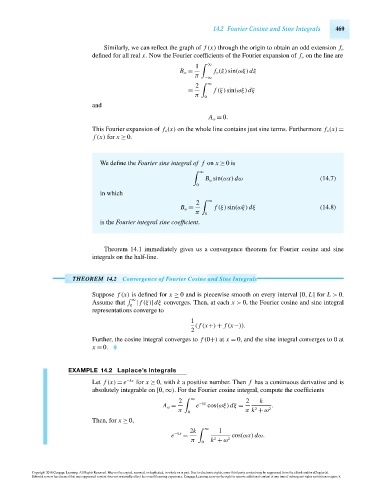Page 489 - Advanced engineering mathematics
P. 489
14.2 Fourier Cosine and Sine Integrals 469
Similarly, we can reflect the graph of f (x) through the origin to obtain an odd extension f o
defined for all real x. Now the Fourier coefficients of the Fourier expansion of f o on the line are
1 ∞
B ω = f o (ξ)sin(ωξ)dξ
π
−∞
2 ∞
= f (ξ)sin(ωξ)dξ
π 0
and
A ω = 0.
This Fourier expansion of f o (x) on the whole line contains just sine terms. Furthermore f o (x) =
f (x) for x ≥ 0.
We define the Fourier sine integral of f on x ≥ 0is
∞
B ω sin(ωx)dω (14.7)
0
in which
2 ∞
B ω = f (ξ)sin(ωξ)dξ (14.8)
π 0
is the Fourier integral sine coefficient.
Theorem 14.1 immediately gives us a convergence theorem for Fourier cosine and sine
integrals on the half-line.
THEOREM 14.2 Convergence of Fourier Cosine and Sine Integrals
Suppose f (x) is defined for x ≥ 0 and is piecewise smooth on every interval [0, L] for L > 0.
∞
Assume that | f (ξ)|dξ converges. Then, at each x > 0, the Fourier cosine and sine integral
0
representations converge to
1
( f (x+) + f (x−)).
2
Further, the cosine integral converges to f (0+) at x = 0, and the sine integral converges to 0 at
x = 0.
EXAMPLE 14.2 Laplace’s Integrals
Let f (x) = e −kx for x ≥ 0, with k a positive number. Then f has a continuous derivative and is
absolutely integrable on [0,∞). For the Fourier cosine integral, compute the coefficients
2 ∞ 2 k
A ω = e −kξ cos(ωξ)dξ = .
π 0 π k + ω 2
2
Then, for x ≥ 0,
2k ∞ 1
e −kx = cos(ωx)dω.
2
π 0 k + ω 2
Copyright 2010 Cengage Learning. All Rights Reserved. May not be copied, scanned, or duplicated, in whole or in part. Due to electronic rights, some third party content may be suppressed from the eBook and/or eChapter(s).
Editorial review has deemed that any suppressed content does not materially affect the overall learning experience. Cengage Learning reserves the right to remove additional content at any time if subsequent rights restrictions require it.
October 14, 2010 16:43 THM/NEIL Page-469 27410_14_ch14_p465-504

